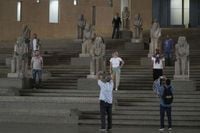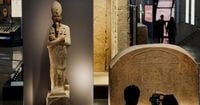With the kind of spectacle that would make even the ancient pharaohs proud, Egypt officially opened the doors to its long-awaited Grand Egyptian Museum (GEM) on November 1, 2025. Nestled on the edge of Cairo, just a stone’s throw from the iconic Giza Pyramids and the Sphinx, the museum’s debut was a dazzling affair—think drone light shows painting gods and pyramids across the night sky, orchestral fanfares, and an international guest list that included European and Arab royals, presidents, and prime ministers. This wasn’t just another ribbon-cutting; it was a statement to the world that Egypt’s millennia-old heritage deserves a stage as grand as its history.
The journey to this moment was anything but straightforward. According to the Associated Press, the project took two decades and $1 billion to complete, with construction first beginning in 2005. Political turmoil, most notably the 2011 Arab Spring uprising, and more recently, the 2025 conflict between Israel and Iran, caused repeated delays. Yet, the result is nothing short of breathtaking: a museum touted as the world’s largest dedicated to a single ancient civilization, with 24,000 square meters (258,000 square feet) of permanent exhibition space and some 50,000 artifacts on display.
At the heart of the opening ceremony, Egyptian President Abdel Fattah el-Sissi called on attendees to “make this museum a platform for dialogue, a destination for knowledge, a forum for humanity, and a beacon for all who love life and believe in the value of humankind.” On social media, he added that the museum “will bring together the genius of ancient Egyptians and the creativity of modern Egyptians, enhancing the world culture and art with a new landmark that will attract all those who cherish civilization and knowledge.” The presidency described the event as “an exceptional event in the history of human culture and civilization.”
Security was tight across Cairo, and the government even declared the day a public holiday. Behind the scenes, preparations were kept under wraps, culminating in a stage built in the museum’s courtyard for what Egyptian media called a “global symphony of humanity.” The sense of occasion was palpable, with lines of actors in ancient garb, orchestras playing, and hundreds of drones lighting up the night sky with images of Isis, Osiris, and the pyramids themselves. In a nod to history, the event echoed the 1869 inauguration of the Suez Canal, when Egypt’s rulers gathered European royalty for another megaproject unveiling.
The museum’s design is itself a modern marvel. Its towering, triangular glass façade mirrors the nearby pyramids, while a granite colossus of Ramses the Great—the legendary pharaoh who ruled from 1279 to 1213 B.C.—greets visitors in the angular atrium. From there, a grand six-story staircase, lined with ancient statues, leads up to the main galleries and offers views of the pyramids. There’s even a bridge connecting the museum to the Giza Plateau, allowing tourists to traverse between the wonders of ancient and modern Egypt on foot or by electric vehicle.
Inside, the museum’s 12 main galleries, which quietly opened last year, showcase antiquities spanning from prehistoric times to the Roman era, organized both by era and by theme. But the real showstopper is the two new halls dedicated to the treasures of King Tutankhamun. For the first time since British archaeologist Howard Carter discovered the boy pharaoh’s tomb in 1922, the entire collection—some 5,000 artifacts—will be displayed in its entirety. This includes Tutankhamun’s three funeral beds, six chariots, golden throne, gold-covered sarcophagus, and the iconic burial mask crafted from gold, quartzite, lapis lazuli, and colored glass.
Egypt’s most renowned archaeologist and former minister of antiquities, Zahi Hawass, didn’t mince words about the museum’s centerpiece. “Why this museum is so important, and everyone is waiting for the opening? Because of Tutankhamun,” he told the Associated Press. The old Egyptian Museum, a stately Neo-Classical building in downtown Cairo, simply didn’t have the space or the modern amenities to do justice to such a collection. Now, with the GEM, Egypt hopes to set a new global standard for the display and interpretation of its ancient treasures, incorporating virtual reality exhibits and state-of-the-art explanations to bring history to life.
The opening of the GEM isn’t just about celebrating the past—it’s a calculated move to secure Egypt’s economic future. The government has spared no expense in revamping the area around the museum, paving new roads, building a new metro station, and even opening the Sphinx International Airport just 40 minutes away. According to Egypt’s Tourism and Antiquities Minister Sherif Fathy, the museum is expected to attract 5 million visitors annually, putting it in the same league as the world’s most popular museums. For context, the Louvre in Paris drew 8.7 million visitors in 2024, the British Museum 6.5 million, and New York’s Metropolitan Museum of Art 5.7 million.
Tourism is big business for Egypt. After years of political upheaval and the blow dealt by the coronavirus pandemic, the sector is finally rebounding. Official figures show a record 15.7 million tourists visited Egypt in 2024, contributing about 8% of the nation’s GDP. The government expects 18 million tourists in 2025, with an ambitious goal of 30 million annually by 2032. The hope is that the GEM will encourage visitors to stay longer, explore more, and, crucially, spend more. As tour guide Walid el-Batouty put it, “It will boost the economy of Egypt tremendously, not just the hotels and the museum itself. Whenever a tourist rides a cab or even just buys a bottle of water, that is pumping money into Egypt’s coffers.”
The museum’s public opening is scheduled for November 4, 2025—fittingly, the anniversary of Carter’s discovery of Tutankhamun’s tomb. With the surrounding infrastructure upgrades, including a metro station under construction and a new airport, Egypt is betting that easier access will translate into more visitors and more revenue. The area around the pyramids and the Sphinx has been spruced up, and a bridge now links the museum directly to the Giza Plateau, making it easier than ever for tourists to experience the full sweep of Egypt’s ancient wonders.
Despite the grandeur and optimism, the museum’s opening comes at a time when Egypt’s economy remains under pressure. Years of stagnation, the aftermath of the Arab Spring, and regional instability have all taken their toll. Yet, the GEM stands as a bold statement of resilience and ambition—proof that, even after thousands of years, Egypt’s fascination with its own history remains undimmed. For visitors and locals alike, the Grand Egyptian Museum offers a new lens through which to view the past and, perhaps, a brighter path toward the future.


